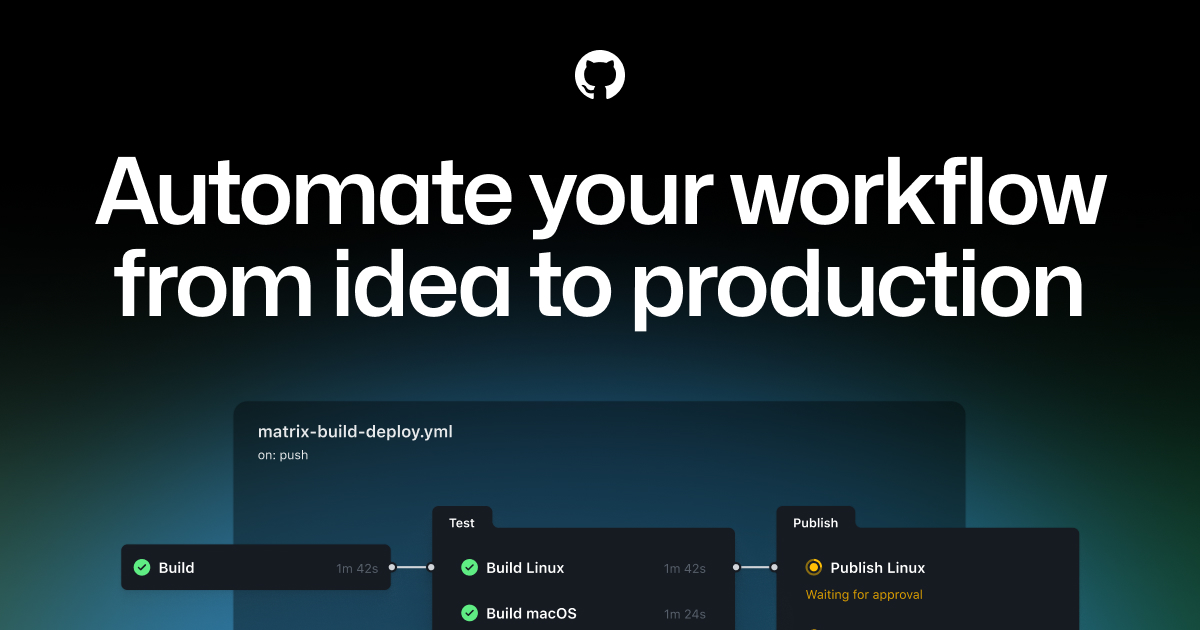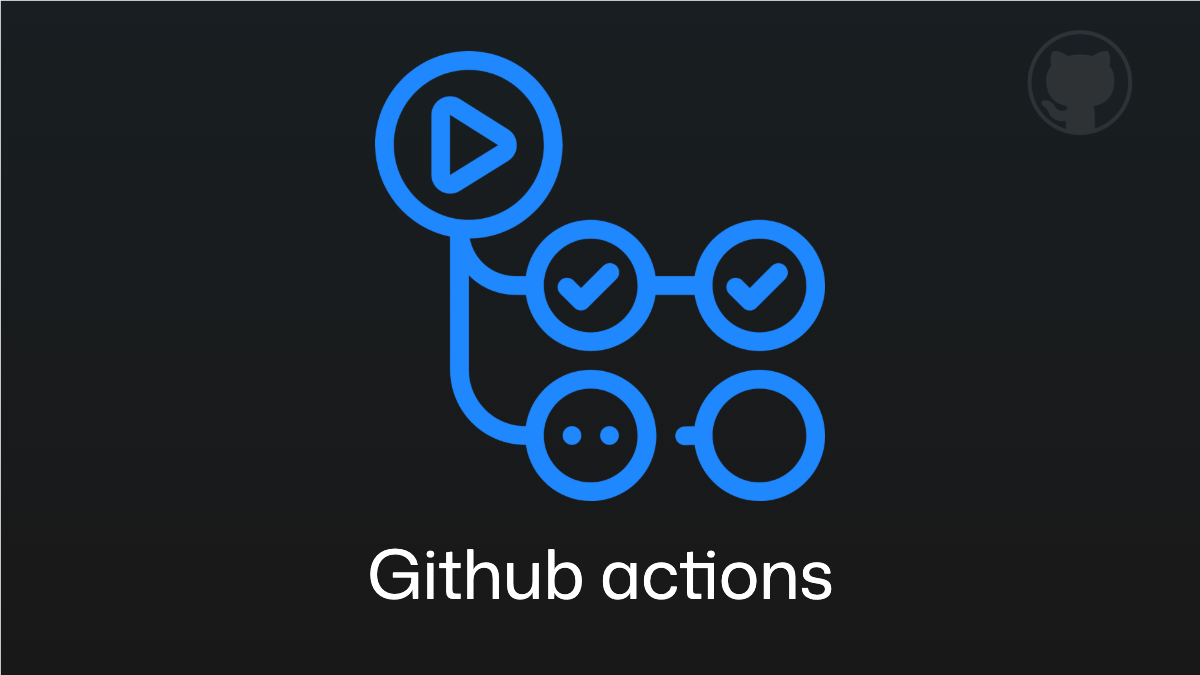Let's try: Github actions for Github integration
With Github Actions, our CI/CD directly connect to Github repo and able to deploy to our GCP services
Speaking of CI/CD tools, I have some old blogs about Google Cloud Build. But today we come to talk about another popular CI/CD tool which comes with Github, that is “Github Actions”.
What is “Github Actions”?
Github Actions is a CI/CD tool comes with Github. When we implemented our own apps in Github repositories, we can use this tool out-of-the-box. Similar to Google Cloud Build, we can control our workflows to run, test, and deploy with simple YAML files.
This is an official page of Github Actions.

Start a first action
Github Actions just needs YAML files inside .github/workflows directory so we’re gonna create a very simple workflow in one YAML file.
1. Create a workflow file
The command below will create an empty file inside that directory.
1
2
mkdir -p .github/workflows
touch sample.yml
So we should have the file in the structure like this.
1
2
3
4
.
└── .github
└── workflows
└── sample.yml
2. Simple echo
We edit the content of .github/workflows/sample.yml file to just say “hello world”, like this.
1
2
3
4
5
6
7
8
9
10
11
12
13
name: "Sample workflow"
on:
workflow_dispatch:
jobs:
prepare:
name: "prepare"
runs-on: ubuntu-latest
steps:
- name: simple echo
run: >
echo "hello world"
nameis a name of this Github workflow.onis an event to run this workflow andworkflow_dispatchmeans we can run this workflow manually.jobsis a section we define each of our jobs.prepareis a job name as a local reference.namehere is the job name to display in the Github Actions page.runs-onis an OS image to run this job. We can useubuntu-latest,windows-latest, ormacos-latestrunners.stepsis a list of steps we want to execute in this job.
3. Review the workflow
When we commit and push it to the default branch, we can find the new workflow here at the “Actions” tab of the repository.
New workflow can be found when the workflow files are ready in the default branch12 or a pull request that have it if the trigger is on
pull_request.
Find out the default branch at the “Settings” tab, under “Branches” section.
As we set on event to workflow_dispatch, this means we can run this workflow manually by selecting the branch and clicking the “Run workflow” button.
When the job ran completely (or failed), we can see the status and the job history like this.
4. Review results
When we clicked the job name, we can see the details of the job.
This job names “prepare” and has only one step, “simple echo” so we can see only one box.
Clicking the “prepare” box will show the output of the step. There is “hello world” under the “simple echo” step.
Some more configs
Variables
We can define variables
1
2
env:
text: "Hello world."
And reference them in the workflow like this.
1
2
3
4
5
6
7
8
9
10
11
env:
text: "Hello world."
jobs:
prepare:
name: "prepare"
runs-on: ubuntu-latest
steps:
- name: simple echo
run: |
echo "${{ env.text }}"
We can also embed variables3 in the repo at “Settings” tab → “Security” section → “Secrets and variables” → “Actions”.
Trigger events
1
2
3
4
5
6
7
8
on:
push:
branches:
- main
pull_request:
branches:
- main
workflow_dispatch: # manual trigger
There are several events to trigger4 the workflow.
pushevent will trigger the workflow when we push to the given branch. It’smainbranch in the example above.pull_requestevent will trigger when we create a pull request to the given branch. It’s also amainbranch in the example.workflow_dispatchevent to run manually.
Job details
1
2
3
4
5
6
7
8
9
10
11
12
jobs:
<job_name>:
name: "<job_name>"
runs-on: <runner>
needs: <job_name> # optional, to run after another job
environment: <environment_name> # optional, to run in a specific environment
steps:
- name: "<step_name>"
run: |
<commands>
outputs: # optional, to define outputs for the job
<output_name>: "<output_value>"
Under jobs, we can define each job and its details5:
name: name of the job to display.runs-on: the runner to run this job. It can beubuntu-latest,windows-latest, ormacos-latest.needs: one or more job names to run before this job as dependencies.environment: a specific environment to run this job.steps: a list of steps to run.name: name of the step.run: commands to run in this step.
outputs: outputs of the job in case we want to parse to other jobs.
Work with Google Cloud
Now we are at the core. When it comes to CI/CD, we usually have to integrate it with some platforms such as GCP.
In this blog, we are going to implement a simple Github workflow to check Google Cloud Storage files through GCP Workload Identity Federation. We need to understand how can we authenticate and let’s see together.
Workload Identity Federation
Workload Identity Federation6 allows us to securely authenticate to Google Cloud Platform without service account keys or other risky methods if we lose them. Instead, we use short-lived tokens as an identity, including impersonating service accounts.
When the setup is ready, our Github actions can connect to the GCP as this diagram.
sequenceDiagram
autonumber
box Google Cloud
participant WIP as Workload Identity Pool
participant WIPP as Workload Identity<br/>Pool Provider
participant SA as GCP Service Account
end
box Github
participant GHA as Github Actions
end
alt setup
WIP ->> WIPP : contains
SA ->> WIPP : binding with principal<br/>or principal set
end
GHA ->> SA : uses
SA ->> WIPP : authorize
activate WIPP
WIPP ->> GHA : access token
deactivate WIPP
There are many ways to setup the GCP Workflow Identity Federation e.g. gcloud CLI7. This blog will use Terraform8 to create the resources.
Create Workflow Identity Federation resources
First, we need a GCP Workload Identity Pool. This resource is currently in
google-betaprovider.1 2 3 4 5 6 7
resource "google_iam_workload_identity_pool" "my_github_pool" { provider = google-beta workload_identity_pool_id = "pool-id" display_name = "pool-name" description = "Identity pool operates in FEDERATION_ONLY mode for testing purposes" }
Deleting a pool has 30 days of grace period which means the deleted pool can be restored and we can’t create a new pool with the same name for the certain period9.
Next is the provider in the pool. There are many ways to setup
attribute_conditionand this time I set the condition to be repo owner10.1 2 3 4 5 6 7 8 9 10 11 12 13 14 15 16 17 18
resource "google_iam_workload_identity_pool_provider" "my_github_provider" { provider = google-beta workload_identity_pool_id = google_iam_workload_identity_pool.my_github_pool.workload_identity_pool_id workload_identity_pool_provider_id = "provider-id" display_name = "provider-name" description = "Provider for GitHub Actions to access Google Cloud resources" attribute_condition = "assertion.repository_owner == 'owner'" attribute_mapping = { "google.subject" = "assertion.sub" "attribute.actor" = "assertion.actor" "attribute.repository" = "assertion.repository" "attribute.repository_owner" = "assertion.repository_owner" } oidc { issuer_uri = "https://token.actions.githubusercontent.com" } }
Deleting a provider has 30 days of grace period which means the deleted provider can be restored and we can’t create a new provider with the same name for the certain period11.
Third, create a service account to connect to the provider.
1 2 3 4 5
resource "google_service_account" "my_service_account" { account_id = "service-account-id" display_name = "service-account-name" description = "Service account for GitHub Actions to access Google Cloud resources" }
We are binding the service account with the role
roles/iam.workloadIdentityUseras a user of the provider.
membersmust be eitherprincipalorprincipalSet12 and assign the corresponding principal identifier13. There are some forums1415 in case of the errors from incorrectmembers.1 2 3 4 5
resource "google_service_account_iam_binding" "github_actions_sa_member" { service_account_id = google_service_account.my_service_account.name role = "roles/iam.workloadIdentityUser" members = ["principalSet://iam.googleapis.com/${google_iam_workload_identity_pool.my_github_pool.name}/attribute.repository_owner/owner"] }
Last, we grant Service Account Token Creator role for impersonation and other necessary roles.
1 2 3 4 5 6 7 8
resource "google_project_iam_member" "github_actions_sa_iam_roles" { for_each = toset([ "roles/iam.serviceAccountTokenCreator", "roles/storage.admin", ]) role = each.value member = "serviceAccount:${google_service_account.my_service_account.email}" }
Create Github Actions with GCP provider
Let’s say we have completed the setup and it’s the time to create a Github Actions to do something with GCP services.
prepare credentials
1 2 3 4
env: PROJECT_ID: <project_id> WLID_PROVIDER: projects/<project_number>/locations/global/workloadIdentityPools/<pool_id>/providers/<provider_id> SA_EMAIL: <service_account>@<project_id>.iam.gserviceaccount.com
We need project id, project number, pool id, provider id, and service account email.
The project number (e.g.
projects/123456789/) is required to authenticate to the provider, or we could see an error when authenticating.checkout16 first and the workflow can access and fetch the repo.
1 2 3
steps: - name: Checkout uses: actions/checkout@v3
authenticate to GCP17 with the service account.
1 2 3 4 5 6
- name: Authenticate to Google Cloud uses: google-github-actions/auth@v2 with: workload_identity_provider: ${{ env.WLID_PROVIDER }} project_id: ${{ env.PROJECT_ID }} service_account: ${{ env.SA_EMAIL }}
setup gcloud18 to configure Google SDK into the Github Actions environment.
1 2 3 4
- name: Setup GCloud uses: google-github-actions/setup-gcloud@v2 with: project_id: ${{ env.PROJECT_ID }}
Example result
At the step “List files”, I run gcloud storage ls gs://... and it successfully returns a list of folders and files in that path.
Debug OIDC Claims
OIDC or OpenID Connect1920 is a protocol to verify the identity of the user or service. At the step of creating provider, we set OIDC URI to be Github that means Github will send a token to GCP to verify.
However, when we have issues with OIDC claims, we can add this step of “actions-oidc-debugger”21 to debug OIDC claims in order to investigate values and other issues in authentication.
1
2
3
4
- name: Debug OIDC Claims
uses: github/actions-oidc-debugger@main
with:
audience: "${{ github.server_url }}/${{ github.repository_owner }}"
Repo
I have setup both Terraform and Github Actions in the repo below.
References
Workflow is not shown so I cannot run it manually (Github Actions) - Stack Overflow
Running a GitHub Actions workflow that doesn’t exist yet on the default branch - Thomas Levesque’s .NET Blog
Workload Identity Federation | IAM Documentation | Google Cloud
Secure your use of third party tools with identity federation | Google Cloud Blog
google_iam_workload_identity_pool_provider | Resources | hashicorp/google | Terraform | Terraform Registry
Allow your external workload to access Google Cloud resources
google cloud platform - github actions to GCP OIDC error: 403 ‘Unable to acquire impersonated credentials’ [principalSet mismatch with the Subject claim] - Stack Overflow
Github actions ‘Unable to acquire impersonated credentials’ from GCP OIDC: error403 [principalSet mismatch with the Subject claim] · Issue #310 · google-github-actions/auth
google-github-actions/auth: A GitHub Action for authenticating to Google Cloud.
google-github-actions/setup-gcloud: A GitHub Action for installing and configuring the gcloud CLI.
Configure Workload Identity Federation with other identity providers | IAM Documentation | Google Cloud
github/actions-oidc-debugger: An Action for printing OIDC claims in GitHub Actions.







